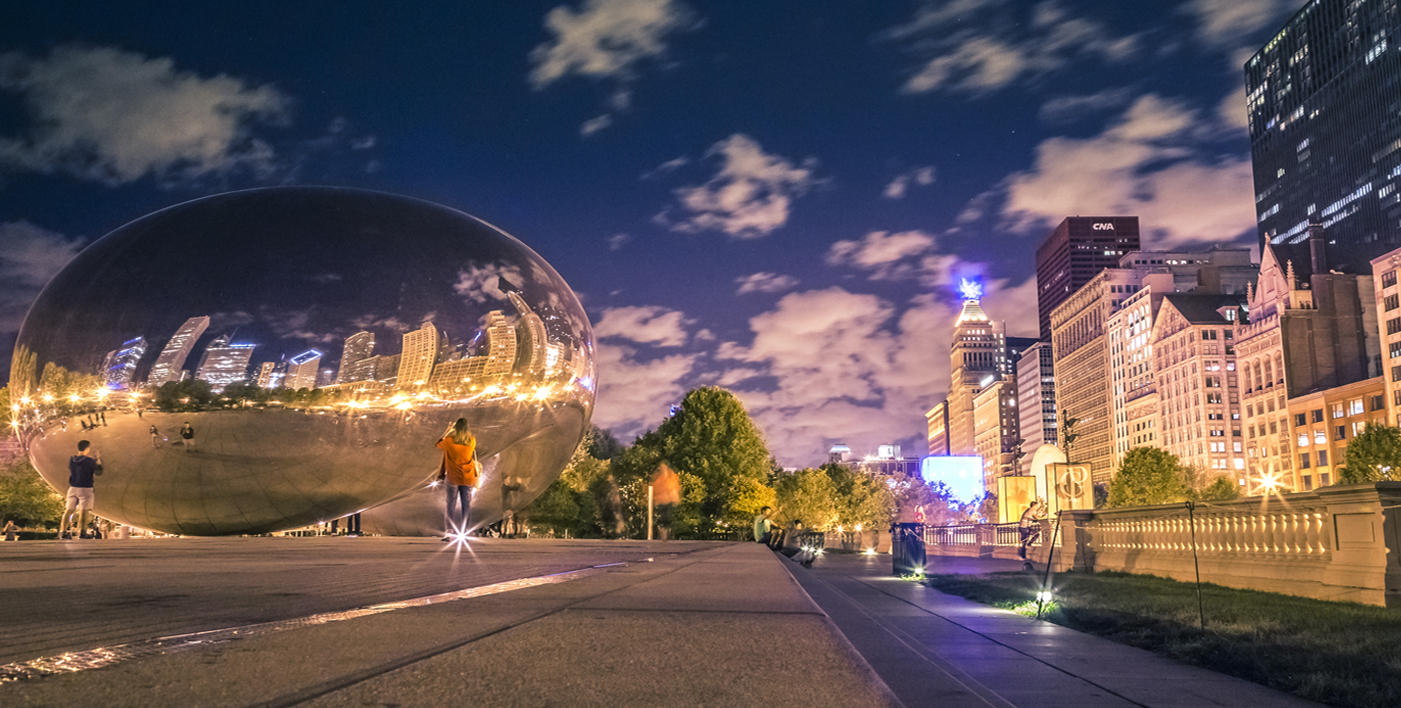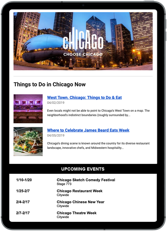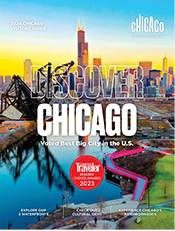Learn fun facts and stats about the Midwest’s biggest city — from record-breaking firsts and celebrated Chicago natives to interesting tidbits and fascinating city history.
City facts
- Chicago rests on 234 square miles of land.
- Chicago is the third largest city in the U.S. and is home to an estimated 2.7M residents.
- Chicago is comprised of 77 community areas.
- Chicago’s nicknames include: The Windy City, City of Big Shoulders, The Second City, The White City, and The City That Works.
- Chicago’s motto, urbs in horto or “city in a garden,” was adopted in the 1830s and alludes to the city’s impressive and historic park system.
- Chicago’s downtown area is known as “The Loop,” which refers to the area encircled by the Chicago Transit Authority’s elevated (‘L’) train tracks.
- The CTA operates the nation’s second largest public transportation system. In an average year, the CTA provides more than 450 million bus and train rides.
- Chicago is known as the United State’s railroad capital, with more major railroads serving the city than any other place in America.
- Downtown Chicago’s underground pedestrian system, known as the Pedway, consists of tunnels and overhead bridges that cover roughly 5 miles and link more than 40 blocks in the Central Business District.
- A unique downtown Chicago feature is its multi-leveled streets, the most well-known of which is Wacker Drive. This double-decker street comprises an upper-level riverfront boulevard and a lower-level roadway for commercial and through traffic.
- There are 135 hotels with 43,881 hotel rooms in the Central Business District.
Chicago history
- The name Chicago was first recorded in 1688, where it appears as Chigagou, an Algonquian word meaning “onion field.”
- Chicago’s first permanent settler in 1779 was Jean Baptiste Point du Sable, a trapper and merchant credited with building the trading post that evolved into Chicago. With French and African parentage, du Sable hailed from Haiti and settled in what was to become Chicago with his Potawatomi wife, Kittihawa. He is honored in Chicago with Jean Baptiste Point DuSable Lake Shore Drive, DuSable Bridge on Michigan Avenue, and the DuSable Museum of African American History.
- Chicago was incorporated as a town in 1833 and as a city in 1837.
- The Great Chicago Fire of 1871 destroyed one-third of the city and left more than 100,000 homeless. Its initial spark remains unknown. FYI: The Chicago Water Tower and Pumping Station on Michigan Avenue, now home to City Gallery and Lookingglass Theatre, are among Chicago’s few remaining pre-fire buildings.
- The 1893 World’s Columbian Exposition, also known as the World’s Fair, was held on the grounds of Chicago’s Jackson Park. The exposition buildings were so striking that they launched the so-called ‘City Beautiful’ movement, which focused on Beaux-Arts aesthetics in American city planning.
- In 1900, Chicago successfully completed a massive and highly innovative engineering project, reversing the flow of the Chicago River so that it would empty into the Mississippi River rather than Lake Michigan. Each year, the Chicago River is dyed green to celebrate St. Patrick’s Day.
Attractions and entertainment
Chicago is home to:
- 28 miles of lakefront with 24 beaches.
- More than 8,800 acres of green space and 600 parks; the Chicago Park District is the largest municipal park manager in the nation.
- Over 300 miles of bike lanes, 18.5 miles of lakefront bicycle paths, and more than 13,000 bike racks and parking areas.
- More than 800 Divvy bike share stations and thousands of Divvy bikes (including 7,000 electric bikes) across the Chicagoland area. In 2021, Chicago recorded a record-breaking 4 million Divvy rides.
- Eight major league sports teams.
- More than 200 theatres, 250 live music venues, and 200 professional dance companies.
- More than 7,300 restaurants and over 160 breweries in the Chicagoland area
- 59 historic districts and hundreds of historic landmarks
- More than 70 music festivals, 36 parades, and over 40 film festivals annually.
- The starting point of “Historic Route 66” at Grant Park on Adams Street in front of the Art Institute of Chicago.
- Lincoln Park Zoo, one of the oldest zoos in the country, and one of the few remaining free zoos in the U.S.
- Willis Tower (formerly Sears Tower) is the second-tallest building in the Western Hemisphere at 1,730 feet tall. Willis Tower held first place until the construction of New York’s One World Trade Center in 2014. Also, the Willis Tower elevators are among the fastest in the world, operating at speeds as fast as 1,600 feet per minute.
- Wrigley Field is the second oldest ballpark in Major League Baseball.
- Approximately 16 examples of Frank Lloyd Wright designs in the city of Chicago, and a further 25 in nearby Oak Park. Frank Lloyd Wright’s Prairie School of architecture originated in Chicago. Two of his Chicago-area designs, the Robie House in Hyde Park and the Unity Temple in Oak Park, are designated as UNESCO World Heritage sites.
- McCormick Place, the largest convention center in the Western Hemisphere.
Art and museums
Chicago is home to:
- More than 60 museums, showcasing world-class art, culture, history, and more.
- Art on theMART is the largest permanent digital art installation in the world.
- One of the largest collections of Impressionist and Post-Impressionist paintings outside of Paris is housed at the Art Institute of Chicago.
- More than 500 public works of art displayed around the city as part of the City of Chicago’s Public Art Program, including pieces by Picasso, Chagall, Miro, and Calder.
- The Museum of Science and Industry, one of the largest science museums in the world. The museum is housed in the only remaining building constructed for the 1893 World’s Columbian Exposition’s “White City.” It was originally built as the exposition’s Palace of Fine Arts.
- The Adler Planetarium, the first planetarium in the Western Hemisphere.
- Máximo the Titanosaur, the largest dinosaur known to man, and SUE, the largest and most complete T.rex specimen in the country, at the Field Museum of Natural History.
- The Chicago Cultural Center, built in 1897, which originated as the city’s first public library, and became the first free municipal cultural center in the United States. The Center is home to the world’s largest stained glass Tiffany dome.
Chicago firsts
People
- In 1907, University of Chicago physicist Albert A. Michelson became the first American to receive a Nobel Prize in the sciences.
- In 1914, the Chicago Tribune hired Jack Lawson as the first paid full-time film critic in the U.S.
- Wallace Carlson and Winsor McCay created the first animated cartoon character with Gertie the Dinosaur in 1914. FYI: The following year, Carlson debuted a new character called “Dreamy Dud,” who appeared in perhaps the country’s first afterschool special for Chicago’s Essanay Studios, made famous by Charlie Chaplin.
- Chicago resident Gwendolyn Brooks became the first African-American woman to win a Pulitzer Prize in 1950 for her book Annie Allen.
- Opera singer Maria Callas made her American debut at Chicago’s Lyric Opera in 1954.
- Roger Ebert at the Chicago Sun-Times became the first person to win a Pulitzer Prize for film criticism in 1975.
- Sen. Carol Moseley Braun became the country’s first female African-American U.S. senator in 1992.
- As 44th President of the United States, Chicago resident Barack Obama became the first African-American to serve in the office.
Innovations
- The world’s first skyscraper, the Home Insurance Company, was designed by Major William Le Baron Jenney and built in Chicago in 1885.
- The game of 16-inch softball, played without gloves, was invented in Chicago. The first known game of its kind took place on Thanksgiving Day 1887 at the Farragut Boat Club.
- Chicago’s ‘L’ train system was the first elevated railway in the United States, debuting in 1892.
- The brownie was created at Chicago’s Palmer House, when Bertha Palmer, wife of millionaire hotelier Potter Palmer, requested a new dessert to serve at the 1893 World’s Columbian Exposition.
- The first Ferris wheel made its debut at the 1893 World’s Columbian Exposition. FYI: Today, Navy Pier is home to a nearly 200-foot Ferris wheel in honor of the original.
- The Twinkie was invented during the Depression by Chicagoan Jimmy Dewar. It was originally filled with banana cream, but bananas were scarce during WWII, so vanilla cream was substituted.
- The Atomic Age began at 3:25 p.m. on Dec. 2, 1942, when an atom was split for the very first time. It all took place under the football stands of Stagg Field at the University of Chicago. Today, Henry Moore’s Nuclear Energy sculpture marks the spot.
- In 1943, Ike Sewell invented deep dish pizza at his restaurant Pizzeria Uno, where Chicago-style pies are still served today.
- The first all-color TV station debuted in Chicago on April 15, 1956 at WNBQ-TV (Channel 5).
- The first televised U.S. presidential candidates’ debate was broadcast from Chicago’s CBS Studios on Sept. 26, 1960, between John F. Kennedy and Richard Nixon.
Culture and the arts
- The first automobile race in America was held on Thanksgiving Day, Nov. 27, 1895. The race was sponsored by the Chicago Times-Herald and ran a 54-mile course from downtown Chicago to Evanston and back.
- The first gay rights organization, the Society for Human Rights, was founded in Chicago in 1924.
- Chicago is the birthplace of Electric Chicago Blues. Developed in the late ’40s and early ’50s, The genre took Delta blues and amplified it in a small-band setting.
- On Jan. 31, 1949, the first TV daytime soap opera, These Are My Children, premiered on NBC in Chicago. It was created by Irna Phillips, later known as the “Queen of the Soaps.”
- Adler Planetarium was the first planetarium in the Western Hemisphere, opening on May 12, 1930.
- In 1933, Major League Baseball’s first All-Star Game took place at Chicago’s Comiskey Park.
- House music originated on Chicago’s South Side in 1977, at famed club, The Warehouse.
- Chicago is the birthplace of Frank Lloyd Wright’s Prairie School of architecture and design.
- Jeanne Gang’s Vista Tower in Chicago’s Loop is the tallest structure in the world to be designed by a woman.
Famous Chicagoans
- Walt Disney was born in the Hermosa neighborhood of Chicago in 1901. He studied drawing at Chicago’s McKinley High School and the Art Institute of Chicago.
- Hugh Hefner, creator of Playboy magazine, was born in Chicago. Playboy Enterprises made its home on Michigan Avenue in the Palmolive Building from 1965 – 1989. The original Playboy Mansion was located in Chicago’s Gold Coast neighborhood.
- Talk show host, actor, and entrepreneur Oprah Winfrey made Chicago (among other cities) her home. Chicago also was the location of the former Harpo Studios, which produced The Oprah Winfrey Show from 1986 – 2011.
- Comedy icon and Saturday Night Live alum Bill Murray was born in Wilmette, IL. He found his calling after becoming part of the cast of Second City in Chicago. Other SNL greats who started their careers in Chicago include John Belushi, Tina Fey, Amy Poehler, Aidy Bryant, Tim Meadows, Chris Farley, Julia Louis-Dreyfus, Fred Armisen, and Seth Meyers (to name a few).
- Though born in New York, Michael Jordan is synonymous with Chicago. He led the Chicago Bulls to six National Basketball Association championships and earned the NBA’s Most Valuable Player Award six times.
- Famed director, actor, dancer, and choreographer Bob Fosse grew up in Chicago’s Ravenswood neighborhood. He is most well-known for musicals such as Sweet Charity, Chicago, Cabaret, and All That Jazz.
- Many acclaimed actors were born, lived, and/or worked in Chicago, including Harrison Ford, Robin Williams, John and Joan Cusack, Vince Vaughn, Jeremy Piven, Kim Novak, Gillian Anderson, David Schwimmer, Melissa McCarthy, Bernie Mac, John C. Reilly, Jack Benny, Raquel Welch, Quincy Jones, John Mahoney, Gary Sinise, Jennifer Hudson, Mandy Patinkin — and the list goes on.
- Clarinetist, composer, and band leader Benny Goodman, aka “The King of Swing”, was born in Chicago.
- Legendary contemporary jazz pianist, composer, and on-air jazz host Ramsey Lewis is a Chicago native.
- Chicago’s contribution to popular music includes the likes of actor, rapper and songwriter Common; Smashing Pumpkins frontman Billy Corgan; and Wilco frontman Jeff Tweedy.
- Though born in Detroit, film director and screenwriter John Hughes moved to Chicago when he was 13 and is considered a Chicago son. His most well-known works include “Brat Pack” cult movies such as Sixteen Candles, The Breakfast Club, Pretty in Pink, and Ferris Bueller’s Day Off.
- Chicago-born, Pulitzer Prize-winning playwright, screenwriter, and director David Mamet is best known for works such as Glengarry Glen Ross, The Untouchables, and Phil Spector.




